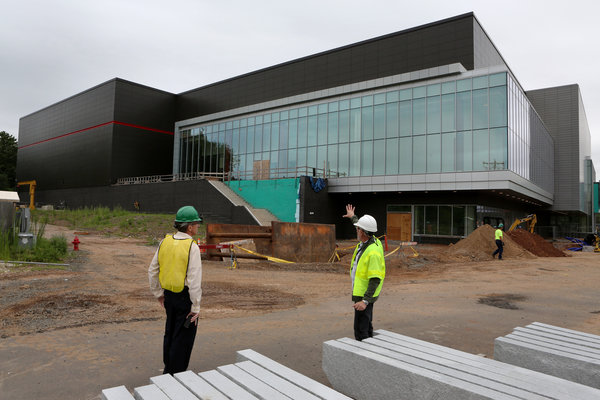 BRISTOL, Conn. — The governor of Connecticut arrived at ESPN’s expansive campus here to celebrate the groundbreaking of the sports media giant’s 19th building, a digital center that would be the new home of “SportsCenter.” It was August 2011, and this was the third visit in a year by Gov. Dannel P. Malloy, whose first was about three weeks before his election.
BRISTOL, Conn. — The governor of Connecticut arrived at ESPN’s expansive campus here to celebrate the groundbreaking of the sports media giant’s 19th building, a digital center that would be the new home of “SportsCenter.” It was August 2011, and this was the third visit in a year by Gov. Dannel P. Malloy, whose first was about three weeks before his election.
This time, Mr. Malloy brought a hard hat, a shovel and an incentive package for ESPN potentially worth $25 million.
ESPN is hardly needy. With nearly 100 million households paying about $5.54 a month for ESPN, regardless of whether they watch it, the network takes in more than $6 billion a year in subscriber fees alone. Still, ESPN has received about $260 million in state tax breaks and credits over the past 12 years, according to a New York Times analysis of public records. That includes $84.7 million in development tax credits because of a film and digital media program, as well as savings of about $15 million a year since the network successfully lobbied the state for a tax code change in 2000.
For Mr. Malloy and other public officials in Connecticut, the conventional wisdom is that any business with ESPN is good business. After all, ESPN is Connecticut’s most celebrated brand and a homegrown success story, employing more than 4,000 workers in the state.
“After I was elected, this was one of the first companies that I came to,” Mr. Malloy told reporters after the groundbreaking ceremony, standing next to a senior ESPN executive, according to a recording of the event. “I made it clear that ESPN’s needs were not going to be ignored by my administration.”
This is peak season for ESPN, which is broadcasting 33 of the 35 college football bowl games, including the national championship game on Jan. 6 between Florida State and Auburn. This spring, it is scheduled to open the 193,000-square-foot Digital Center 2, which is being built with Malloy’s pledge of nearly $25 million in state support. Workers there recently constructed the massive studios that will house ESPN’s flagship lineup of shows. The main hallways in the building were designed to be wide enough to fit a racecar.
The state’s generosity toward ESPN, a multibillion-dollar conglomerate, is not unlike the treatment other major companies have received in Connecticut and throughout the country, like Boeing in South Carolina and General Motors in Michigan. But the breaks have been met with frustration by some political opponents of the Connecticut governor, who say the state’s resources would be better spent elsewhere.
The critics say incentives should be redirected to smaller companies that are more in need than ESPN, which accounts for nearly half the operating profit of Disney, its corporate parent. They also say ESPN, sitting on 123 acres in central Connecticut, is hardly a risk to move elsewhere.
“These people had courage and imagination, so they deserve their success,” State Senator Tony Guglielmo, a Republican, said. “But I don’t think the taxpayers here in our state should be funding it.”
The critics say ESPN has been successful in getting an audience at the State Capitol in Hartford partly because of its ability to communicate its needs effectively to the state’s decision makers. ESPN employs one of the top lobbying firms in Connecticut and has spent $1.2 million on lobbying expenses since 2007, records show.
But Mr. Malloy, a Democrat who will be up for re-election in 2014, says no lobbying is needed to convince him of what he considers obvious: ESPN is one of Connecticut’s best resources, and the state must use all tools available to aid its growth and keep its home base and the thousands of well-paying jobs it promises in Bristol.
He sees ESPN as a magnet for attracting other sports media jobs to his state. NBC Sports, which also received state benefits, recently opened its new headquarters in Connecticut. “I don’t want to imagine Connecticut without ESPN,” Mr. Malloy said in a telephone interview, adding that state incentive programs benefited large and small companies. “We want ESPN to have the biggest possible footprint in Connecticut, and we want them spending their dollars in Connecticut instead of any other state.”
Building Up Bristol
Everyone seems to agree that ESPN is a shining success story for Connecticut, in terms of the state’s early support of an upstart through its development into an international powerhouse. The company’s executives acknowledge that state and local officials have played important roles in their success. But they also say their company has provided an exceptional return on the investment. For the past 25 years, Connecticut has been last in the nation in job creation, with no net job creation over that period.
“Consistently since we launched, we’ve been a growth engine for economic development in central Connecticut,” said Mike Soltys, an ESPN spokesman, who has worked for the company since 1980. “We’ve added employees on a consistent basis for 33 years in a state that in recent years hasn’t had as much success bringing companies that hire people here.
“Because we are visible and highly successful, the state can point to us as a company that loves being here and has flourished being in Connecticut.”
Since 2000, ESPN has spent about $1 billion on construction in and around Bristol, a town of about 60,000, erecting 13 new buildings and expanding several others. During that period, the company’s work force in Connecticut has swelled from 1,700 to more than 4,000. That makes ESPN the 25th-largest employer in the state, according to rankings by the Hartford Business Journal.
The company has a reputation as a first-rate corporate citizen in Bristol, where ESPN laid roots in 1979. It is by far the city’s largest employer and taxpayer, with an assessment dwarfing that of the next nine companies combined. ESPN has also been a significant donor, underwriting the Boys and Girls Club in Bristol, donating to the hospital and children’s museum, and sending out employee volunteers to build a baseball diamond for a low-income housing complex, all with little fanfare.
“I wish everyone was that good,” said Frank N. Nicastro Sr., a Democratic state representative from Bristol and a former mayor. “I’ve watched them grow from a little acorn to an unbelievable size. They’ve done wonders for the city of Bristol.”
The network’s Connecticut origins stem from its founder, Bill Rasmussen, an executive with the Hartford Whalers who wanted to use satellites to beam Whalers and University of Connecticut games to cable television subscribers. The fact that ESPN made its home in Bristol, an old manufacturing town about halfway between New York and Boston, was a point of pride to locals.
Politicians who were not on board with ESPN did not find much success: One mayoral candidate campaigned against the network’s dishes, saying they were a danger to birds. That message did not register in a place that was quickly emerging as the home of ESPN.
“ESPN is huge,” said Ken Cockayne, a city councilman for several years who took over as mayor in November. “They are our largest taxpayer and they are a great corporate partner for our city.”
Incentives to Stay
By the spring of 2000, ESPN had shed its roots as a small start-up and was beginning to look more like a mature corporate behemoth.
Disney, its owner, looked to ESPN as a key part of its revenue machine and one poised for immense growth. The network had 1,700 employees in Bristol, and another 700 worked elsewhere — as the network now had facilities or subsidiaries in seven other states.
That is when ESPN did what other big, multinational companies had done: It went to the statehouse in Hartford and sought financial incentives in exchange for continued growth in Connecticut. At the top of ESPN’s agenda was supporting a measure by state lawmakers that would change the corporate tax formula in a way that would save broadcasters money.
The legislature had done this three years earlier for financial companies. If the adjustment was applied to broadcasters, ESPN stood to be the biggest beneficiary by far — reducing its taxes by about $15 million a year.
Edwin M. Durso, a senior ESPN executive, testified before lawmakers in March 2000 that such a change would encourage the network to embark on a major capital project that would include as much as $500 million in spending, and up to 1,000 new jobs. The network’s initiative was also likely to spur its suppliers and other nearby companies to grow, too, Mr. Durso said, creating a multiplier effect.
Asked by a lawmaker if ESPN would consider putting the development in another state, Mr. Durso referred to the corporate connection to Disney: “They have facilities in many different states.”
The lawmakers were pleased to have ESPN on hand; one even stated, “for the record,” that he watched “SportsCenter” “two nights a week during the legislative session” but “four nights a week the rest of the year.”
The lawmakers approved the change to the corporate tax formula, and a review by Connecticut’s Office of Legislative Research in 2004 showed that ESPN was fulfilling its promise to the legislature. That year, ESPN opened the 136,000-square-foot Digital Center 1.
In 2006, as ESPN continued to grow, the Connecticut General Assembly, along with Mr. Malloy’s predecessor, M. Jodi Rell, had designs on expanding the state’s digital media sector. They wanted to offer tax incentives to companies that use the state as a base for initiatives like making films, building studios and increasing their online operations. Since the program began, the state has awarded about $450 million in tax credits to businesses that have spent $1.6 billion in the state.
ESPN has been among the largest participants in that program, spending $318 million in Connecticut and receiving $84.7 million in tax certificates — about a fifth of the total amount awarded. Companies like Blue Sky Studios and World Wrestling Entertainment have also benefited.
The program has provided ESPN with financial incentives for the development of ESPN.com ($54 million) and ESPN Mobile ($3.2 million), as well as infrastructure credits for the construction of a research and development building ($6.6 million) and the Digital Center 2 ($14.4 million). ESPN also qualified for $6.2 million in credits to support the production of “The Bronx Is Burning,” a television mini-series.
ESPN regularly sells the tax credit certificates to other entities in private transactions, which could mean that the network receives less value than the amount on the voucher. Such transfers are common and within the rules of the program.
George Norfleet, the director of the state’s Office of Film, Television and Digital Media, said he was in regular contact with ESPN, treating the network as a “corporate constituent” with room for growth. “We want to make sure that happens here, not in Orlando or Los Angeles,” he said.
A recurring theme in ESPN’s dealings with the state is that the company could move its operations elsewhere. When Malloy announced ESPN’s inclusion in “First Five,” a state plan to create jobs and promote business development, he said the network had other places where it could have invested. He mentioned recent production facilities in Los Angeles and Austin, Tex.
Some lawmakers who oppose the governor have questioned whether such a shift was a legitimate concern. “If you listen to the governor, they always claim these companies are on the precipice of moving a large, important division,” said Larry Cafero, the Republican leader in the Connecticut House of Representatives.
“You scratch your head and say, Why are we giving them this money?” he said. “Why are we giving them these breaks if there’s no immediate threat to leave?”
Mr. Malloy, for his part, is comfortable with the state’s ties to ESPN. In fact, the governor said he would like more of them.
“We want a larger footprint for ESPN in Connecticut rather than a smaller footprint for ESPN in Connecticut because we know that a large footprint is harder to move out,” Mr. Malloy said.








